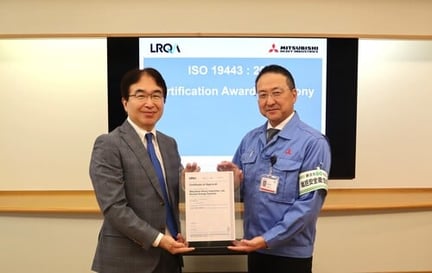Martin Cottam, Chair of ISO/TC 283, gives an update on what’s in the pipeline for ISO 45001.
Over 70 delegates met recently in Coventry, UK, for the first meeting of ISO/TC 283 – the committee responsible for maintaining and developing the international standard for Occupational Health and Safety, ISO 45001. The delegates represented the national standards bodies of 36 participating countries, together with liaison bodies including trade union and employer organisations, professional institutions and certifiers.
What was the aim of this first meeting and what were the outcomes of the meeting?
The aim of the meeting was two-fold; to agree the committee’s work programme and to start work on its initial work items. We agreed that we will work on the two new work items that were proposed ahead of the Coventry meeting and approved by a ballot of national standards bodies.
These work items are a Handbook on Occupational Health and Safety (OH&S) management aimed at smaller organisations, and a Guidance Standard on psychological risk in the workplace. We discussed possible future work items around incident investigation, OH&S metrics and on the role of top management, including non-executives, but decided to defer formalising proposals on any of these for the moment. We will also defer work on a proposal for a formal guidance standard, while work on the more informal handbook gets underway.
What more can you tell us at this stage about the Handbook and Guidance Standard?
The Handbook for smaller organisations is being fast-tracked. Our ambition is to complete this by the end of 2019, which is quite an ambitious timeframe. We will need to do much of the work in virtual groups via webinars, which is not easy for such a widely-dispersed international group, but everyone is up for the challenge.
The Guidance Standard on psychological risk in the workplace will follow the more typical 3-year development schedule. As it will be a formal standard, it will involve several periods of consultation, both with national mirror committees and with the public.
The overarching issue for the committee is to maximise the impact that ISO 45001, and any future documents that we publish to support it, have on global OH&S performance.
What are the main OH&S concerns for the committee members currently?
The overarching issue for the committee is to maximise the impact that ISO 45001, and any future documents that we publish to support it, have on global OH&S performance. The publication of standards and guidance is merely a means to help organisations improve the health and safety of their workers. We believe the framework of ISO 45001 can help organisations achieve this but only if they are aware of, and use, the materials – and do so in a way that really targets their risks and avoids adding bureaucracy.
How do you ensure that the committee and the ISO 45001 standard remain relevant?
The ISO structure is very much designed to help with this. Each national standards body typically has a “mirror Committee” of stakeholder representatives who together formulate the input that their delegates then contribute to the committee.
These committees vary in size but typically have 30-50 members, and in at least one case, over 100! So there are a lot of stakeholders involved both in determining priorities and in shaping individual deliverables. And on top of this, public consultation is part of the development process for formal standards, so it’s a very inclusive process.
What has the uptake of ISO 45001 been in the first 6 months since its launch?
ISO periodically carries out surveys to gather data on the number of organisations certified to each of the major Standards, but ISO 45001 was published too recently to have been included in the last survey. And of course, certification is only one way in which organisations can measure or demonstrate compliance to a standard.
Anecdotally, the evidence suggests that the new Standard has been well received and that it will attract not only organisations currently certified to OHSAS 18001, but also those who haven’t previously used a standard to help them manage OH&S.
Do you have any examples of how the standard has impacted OH&S performance to date?
At this stage, relatively few companies have completed the migration to the new standard, so it’s too early to measure its impact. There is positive feedback on the areas where ISO 45001 has extended the requirements of OHSAS 18001 but at this stage, such reactions are just about people feeling the changes are positive.
The real test will be whether the new requirements have a positive impact on organisations’ OH&S performance. And of course, it’s important to remember that the greatest impact of ISO 45001 is probably not going to be on organisations already certified to OHSAS 18001, but on organisations who have not adopted OHSAS, and who have yet to establish an OH&S management system framework.
What are the benefits to businesses of a systematic approach to OH&S management?
I think there are many benefits to a structured and systematic approach to OH&S management, so I’ll just mention a couple that I think are important. Firstly, the fact that a structured process encourages us to recognise and manage change. So many OH&S failures have poor change management at their heart and a structured approach increases the likelihood that we identify the risks associated with a change, whether planned or unplanned, and can take appropriate action to mitigate the risks.
Secondly, a formal, systematic approach to OH&S management can help draw senior leadership into the process – giving them the opportunity to participate rather than OH&S being delegated down into the organisation and effectively being ‘off their radar’.
You’ve mentioned previously about the aim to increase uptake among micro, small and medium enterprises. How is the committee supporting this?
The fact that one of our first work items in a handbook on the implementation of ISO 45001 aimed specifically at smaller organisations, is a sign of how important this area is.
Such a large proportion of the global workforce is employed in micro, small and medium organisations and despite their size, these organisations are not necessarily low risk. However, they don’t necessarily have the same depth of OH&S expertise as larger organisations and are often less aware of where to find good practice and other support materials, including standards. We’re keen to find ways of raising awareness of ISO 45001 in such organisations and to show how its principles apply to smaller organisations.
With participants and stakeholders from all over the world, ISO/TC 283 has the breadth of expertise and support to achieve its aim of maximising the impact of ISO 45001 to help organisations improve the health and safety of their people.
It’s clear when talking to Martin that the focus is on making the support materials practical and reducing bureaucracy wherever possible. With ambitious plans for a Handbook for smaller organisations to be produced during 2019 and a longer-term project to develop a Guidance Standard on psychological risk in the workplace, LRQA will continue to report on developments and progress as it happens.













